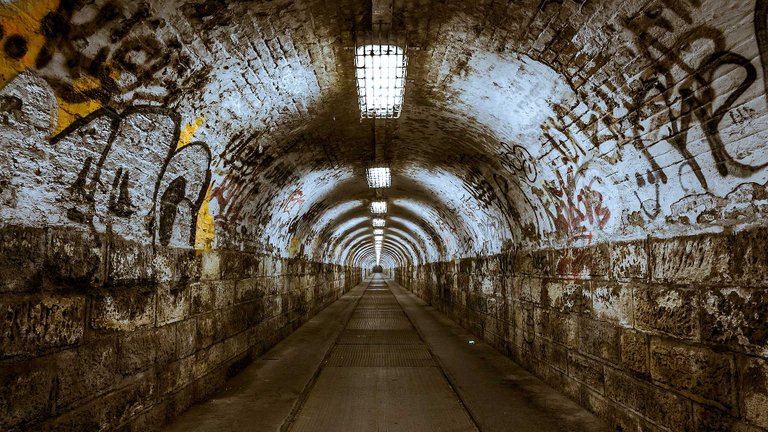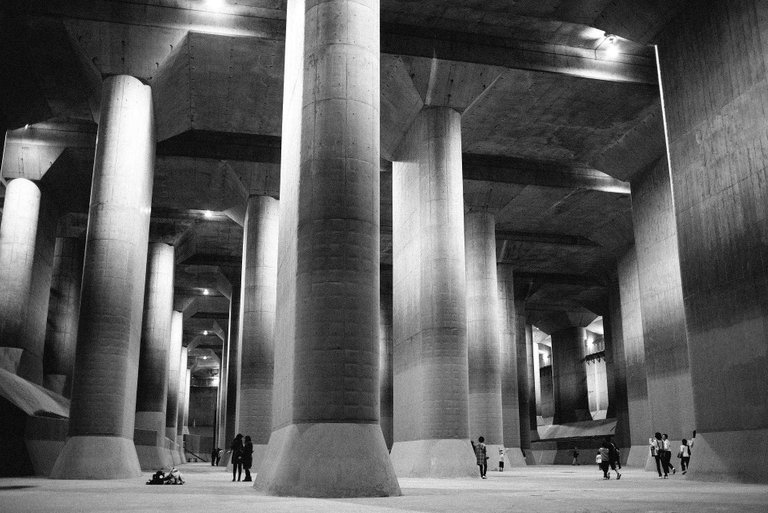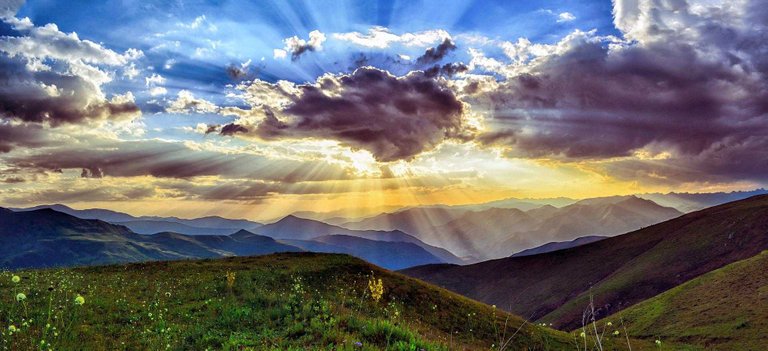Sun and heat
The sun burned mercilessly, not even the plants could process the strength of the radiation emitted by our beloved star. There were no more natural-born plants; the strongest species died within few days of direct exposure. The hardest rocks also eroded with the high temperatures. The earth surface itself became a fine red dust. Sandstorms were commonplace.
Waves of intense heat roared across the surface like hungry beasts. All external water reserves disappeared by a strong evaporation that never gave back a single drop. Only groundwater springs made it possible to preserve life after the breaking of an important layer in the atmosphere and the exhaustion of resources in the surface of the earth. As a result of all this, human life migrated several feets underground.
Sol y calor
El sol quemaba de forma inclemente, ni siquiera las plantas podían procesar la fuerza de la radiación que emitía el astro rey. Ya no había plantas que nacieran naturalmente, las especies más fuertes morían a los pocos días de exposición directa. Las rocas más duras también erosionaban con las altas temperaturas. La tierra misma se convertía en un polvo rojo muy fino. Las tormentas de arena estaban a la orden del día.
Olas de calor intenso recorrían la superficie. Todas las reservas de agua externas desaparecieron por efecto de una fuerte evaporación que nunca devolvía el preciado líquido. Solo los manantiales subterráneos permitieron preservar la vida luego del rompimiento de una importante capa en la atmósfera y el agotamiento de los recursos en la superficie terrestre. Como resultado de todo esto, la vida del hombre migró varios metros hacia el interior de la tierra.

source/fuente
Life under ground
Man had developed a close communion with the depths, special urban architectures had been designed in gigantic blocks connected to each other. The smallest of these was able to hold some five hundred housing units with schools, hospitals, commercial and recreational centers. Most of the energy used came from strong solar radiation, which was reprocessed and filtered by expert systems and even reused for lighting.
Several hundred years passed since the common man lost contact with the surface. Only a few people who knew about history had the hope of restoring life on the surface, as it was in the beginning. From this was born a group of academics who argued that it was possible to repair the hole in the atmosphere. They presented these theories to the world, but nobody understood and nobody was interested in them. Life underground was too comfortable, they didn't need anything from the surface. That was the most widespread opinion in that underground community.
Vida bajo tierra
El hombre había desarrollado una estrecha comunión con las profundidades, se habían diseñado arquitecturas urbanas especiales en bloques gigantescos conectados entre sí. El más pequeño de ellos era capaz de albergar unas quinientas unidades habitacionales con escuelas, hospitales, centros comerciales y recreacionales. La mayor parte de la energía usada provenía de las fuertes radiaciones solares, que eran re-procesadas y filtradas por sistemas expertos y reutilizadas incluso para iluminación.
Algunos cientos de años pasaron desde que el hombre común perdió contacto con la superficie. Solo unos pocos que conocían de historia ahnelaban la restauración de la vida en la superficie, como era en el principio. De allí nació un grupo de catedráticos que sostenían que era posible reparar el agujero en la atmósfera. Presentaban al mundo estas teorías, pero nadie comprendía y a nadie le interesaban. La vida bajo tierra era demasiado cómoda, nada necesitaban de la superficie. Esa era la opinión más extendida en aquella comunidad subterránea.

source/fuente
End-of-world theories
Along with the theories that tried to defend and demonstrate the feasibility of the return to the surface, other theories arose that said that underground life was unsustainable over time. They said that radiation was slowly gaining ground on the surface, while man could not go down indefinitely.
Most of these theories had extremely strong arguments, but they were up against an elite group that ran the world politically. This group lived in the most sophisticated technological conglomerates. They refused to give credit to the possibility of a collapse of the civilization they knew, but, above all, they refused to abandon the life they were used to.
Teorías del fin del mundo
Junto con las teorías que intentaban defender y demostrar la factibilidad del retorno a la superficie, surgieron otras teorías que decían que la vida subterránea era insostenible a lo largo del tiempo. Decían que las radiaciones iban ganando terreno lentamente en la superficie, en tanto que el hombre no podría bajar de nivel indefinidamente.
La mayoría de estas teorías tenían argumentos extremadamente sólidos, pero se enfrentaban a un grupo de élite que dirigía políticamente el mundo. Este grupo vivía en los conglomerados tecnológicos más sofisticados. Se negaban a dar crédito a la posibilidad de un colapso de la civilización que conocían, pero, sobre todo, se negaban a abandonar la vida a la que estaban acostumbrados.

source/fuente
Heat from below
Theories emerged announcing a response of the earth to external heat. They talked about an increase in pre-volcanic activities in places where these signals had never been seen before. A warning voice arose and there was a moderate collective panic, until ABDEL SÂMI' ASHGAR, president of The Union, the world government, appeared on a global network:
—"We wish to disprove that unhealthy rumor that speaks of a heat wave from within the earth. We make it clear that none of this has been confirmed and is only unsubstantiated rumor. If such a thing were to happen, 'The Union' is the only valid entity to raise the alarm. In the meantime, we urge the population to remain calm."
That statement succeeded in calming the mood, but by that time there were already several incidents of spontaneous fires that were being investigated. It was clarified that, in all cases, the fire had its origin in an unexplained heat wave coming from below. More than forty similar incidents followed.
Calor desde abajo
Surgieron teorías que anunciaban una respuesta de la tierra al calor externo. Hablaban de aumento en actividades pre-volcánicas en sitios donde nunca antes se habían visto estas señales. Surgió una voz de alerta y hubo un moderado pánico colectivo, hasta que apareció en cadena global, ABDEL SÂMI' ASHGAR, presidente de La Unión, el gobierno mundial:
—"Queremos desmentir ese rumor malsano que habla de una ola de calor desde el interior de la tierra. Aclaramos que nada de eso ha sido confirmado y vienen a ser solo rumores sin fundamento. Si una cosa así llegara a suceder, 'La Unión' es el único ente válido para elevar la voz de alerta. Mientras tanto, exhortamos a la población a guardar la calma."
Aquella declaración logró aplacar los ánimos, pero ya para ese momento existían varios incidentes de incendios espontáneos que estaban siendo investigados. Se aclaró que, en todos los casos, el siniestro tuvo su origen en una inexplicable onda de calor que venía desde abajo. Luego de esto sucedieron más de cuarenta incidentes similares.

source/fuente
Desperate actions
The Union decided to consult a group of scientists who had previously defended the thesis that it was possible to repair the hole in the atmosphere.
—"But can this really be done?" asked The Union emissary.
Anand Gupta, head of the group of scientists, replied:
—"We believe that the procedure we have analyzed has more than an 87% chance of success. Nature itself is trying to repair the damage, it just needs a little help. 53 world-renowned specialists in the field have endorsed this information. There is a small chance that the project will end up further damaging the atmosphere and shortening human life, but at the other end of the spectrum, we are sure that incidents of spontaneous fires will continue to increase. We have calculated that if we don't take action now the existence of human kind is doomed to less than a hundred years."
In the end, a satellite launch was authorized to analyze the hole in the atmosphere closely. That hole was subsequently blasted with particles that were to produce a magnetic reaction in other particles scattered in that space, and which would eventually close the hole.
Several days passed without a confirmed result. On the seventh day, it started to rain...
It rained for forty days straight, the surface of the earth was completely covered with water. The urban design of the blocks were anti-seismic and anti-flood. They managed to withstand the 70 days it took for the devices to detect the first areas of the surface where the water had disappeared. One hundred and fifty days passed when the news was given that the surface was now suitable for life.
The first caravans to see the "new land" were heading for the surface. Everyone was surprised to see the mountains full of green grass.
—"How is it possible? Where did these plants come from?" asked the first curious one.
And another answered:
—"It seems that our technology was not needed here, nature itself took care of saving seeds to repopulate the new world. A miracle of God..."
Acciones desesperadas
La unión decidió consultar a un grupo de científicos que antes habían defendido la tesis de que era posible reparar el agujero en la atmósfera.
—"Pero..., ¿de verdad esto se puede hacer?"—preguntaba el emisario de La Unión.
Anand Gupta, cabeza del grupo de científicos, contestaba:
—"Creemos que el procedimiento que hemos analizado tiene más de un 87% de probabilidades de éxito. La naturaleza misma intenta reparar el daño, solo necesita un poco de ayuda. 53 especialistas mundialmente reconocidos en el área han avalado esta información. Hay una pequeña posibilidad de que el proyecto termine dañando más la atmósfera y acortando la vida del hombre, pero en el otro extremo, tenemos la certeza de que los incidentes de incendios espontáneos van a seguir aumentando. Hemos calculado que si no actuamos ahora la existencia de la especie humana está condenada a menos de cien años."
Al final, fue autorizado el lanzamiento de un satélite para analizar de cerca el agujero en la atmósfera. Aquel agujero fue posteriormente bombardeado con partículas que debían producir una reacción magnética en otras partículas esparcidas en ese espacio, y que eventualmente cerrarían el agujero.
Pasaron varios días sin que se pudiera comprobar un resultado positivo. Al séptimo día, comenzó a llover...
Llovió durante cuarenta días seguidos, la superficie de la tierra fue totalmente cubierta de agua. El diseño urbano de los bloques eran anti-sismo y anti-inundaciones, logró soportar los 70 días en que tardaron los aparatos en detectar las primeras zonas donde el agua había descendido. Ciento cincuenta días pasaron cuando se dio la voz de que la superficie ya era apta para la vida.
Las primeras caravanas para ver la "nueva tierra" se dirigían a la superficie. Todo el mundo se sorprendió de ver las montañas llenas de hierba verde.
—"¿Cómo es posible? ¿de dónde salieron esas plantas?"—preguntó el primer curioso.
Y respondió otro:
—"Parece que aquí no hizo falta nuestra tecnología, la naturaleza misma se ocupó de guardar semillas para re-poblar el nuevo mundo. Milagro de Dios..."

source/fuente
Text Credits: Amaponian Visitor (@amaponian)

You have a way with sci-fi, @amaponian! It's a pleasure to read your work. In this story, you create a future and a reality that is not too hard to imagine, given the concerns for global warming today. Perhaps scientists can repair our atmosphere in real life.
Thank you for posting your story in The Ink Well. Please remember to read and comment on the work of other authors in the community. We ask everyone who posts in The Ink Well to read and comment on at least two stories for each one published. Thank you!
Thank you for your comment. I'm commenting on other author's posts.
Oh my, I hope it does not come to that and we all have to move underground!
Great story, @amaponian. I love your imagination.
Thanks for passing by.
A true miracle indeed. I like the idea of the world having to hide from the atmosphere though it's pretty much a scary idea too.
I enjoyed your story.
Thanks for passing by.
Quite an interesting story you have here dear friend. Quite a catchy topic and I like the way you took your time in making this a master piece.
Thanks for sharing this with us dear friend
Thanks, @gi-de-on, for passing by.
My.....what a story...I certainly got a little scared thinking how it'll be if things like this ever become a reality...I like how you tell your stories..it takes you on a journey and intrigues you every step of the way..
Great story ❤️
Thank you.
La preocupación mundial por el calentamiento y otros problemas que nos mantienen en vilo. Excelente siempre tus aportes para seguirlos hasta el final. Los llamados milagros inexpicables que dan vida, siempre seran el mejor resultado para creer en él. Un abrazote @amaponian
Sí, ha sido un milagro que aún hubiera simiente vegetal en la tierra. Seguro que esas semillas estaban bien enterradas, igual que la gente, y las aguas las desenterraron y las esparcieron. Como decían en la película Jurassic Park: "La naturaleza se abre camino".
This is an interesting read and I must say, the topic is catchy. You also took your time to draft this. Nice work.
Thanks, buddy!